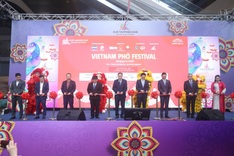Vietnam will export around 180,000 tonnes of cashew nuts, earning more than US$1 billion this year, the highest value ever, according to the Vietnam Cashew Nut Association (VCNA). Since 2007, the cashew nut sector in Binh Phuoc province, which is considered a “cashew metropolis” has developed strongly. Processing factories in the province are currently gearing up production to meet contract orders with partners. Most businesses have already fulfilled their production plans for the whole year.
Since 2007, the cashew nut sector in Binh Phuoc province, which is considered a “cashew metropolis” has developed strongly. Processing factories in the province are currently gearing up production to meet contract orders with partners. Most businesses have already fulfilled their production plans for the whole year.
The Thien An Company had planned to export 1,700 tonnes of cashews this year, however, it has already exported more than 1,800 tonnes, earning more than US$12 million, up 150 percent compared to last year. Vietnam’s cashew nut exports achieved such high results because raw cashew nut harvests in India, Brazil and Indonesia decreased sharply while the world demand is increasing strongly. In addition, Vietnamese cashew nuts are high quality and they are favoured by American and European consumers. The export price rose by 28-30 percent compared to last year.
Vietnam is the biggest exporter of cashews in the world. This year is the first time cashews have joined the country’s list of products with an export value of more than US$1 billion a year.
However, the sector is facing several challenges. First, materials are becoming scarce and the price of raw materials hit a record high of VND35,000 per kilogram. Meanwhile the current export price of cashews is the same as their highest price in 2007 - US$7 per kilogram. Therefore, export businesses’ profits will increase due to exchange rate between the US dollar and Vietnam Dong. On the other hand, being too dependent on export markets poses inherent risks as it means it is governed by prices on the world market. Only 4-5 percent of the sector’s products are consumed in the domestic market. Therefore, the VCNA must find ways to boost domestic consumption.
VCNA president Nguyen Thai Hoc says the sector must promote the nutritional benefits of cashew nuts in the domestic market. Vietnam has a population of more than 80 million as well as many foreign visitors and investors. If our products are good enough they will be consumed at home, Hoc says.
The Ministry of Agriculture and Rural Development has set a target of consuming 30 percent of the cashew nut production in the domestic market by 2020, he adds.
Another challenge facing the cashew nut sector is weak business capacity that does not meet international standards, such as HACCP and GMP to improve the Vietnamese cashew nut’s prestige on the international market. Only 5 percent of the cashew businesses in Binh Phuc, the country’s largest cashew producing areas with more than 200 factories, have met the international criteria for exports.
Furthermore, while the production and processing capacity of businesses in Binh Phuoc is about 200,000 tonnes per year, they only process around 50,000 tonnes and the remainder has to be imported. The shortage of raw materials and price hikes will cause many difficulties for businesses in the next crop.
Currently, cashew nuts are competing fiercely with other tree crops, especially rubber, because the price of rubber has stayed high over the past several years. Therefore, if the cashew sector does not take measures to step up intensive farming, improve productivity and expand growing areas it will find it difficult to maintain its export value of more than US$1 billion in the next few years.
Cashew exports surpass US$1 billion
Vietnam is forecast to export around 180,000 tonnes of cashew nuts, earning more than US$1 billion this year, the highest value ever.
Source: VOV




















